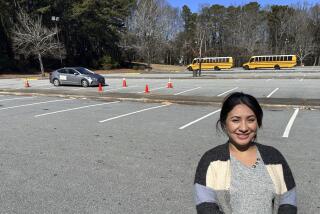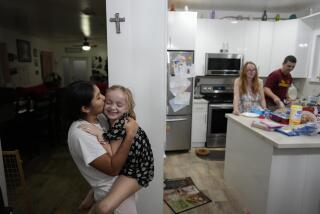Kentucky Program Takes Aim at Migrants’ Cycle of Poverty : Education: ‘Recruiters’ travel back roads to find workers’ children and keep them in school. The effort has won raves from national authorities.
- Share via
MADISON COUNTY, Ky. — At one of the bends in a country road that hugs Tates Creek, in a little house that badly needs paint and new furniture, a 10-year-old girl harbors a modest dream that her parents and grandparents, migrant tobacco workers, couldn’t afford.
Kathy Saylor thinks maybe she will be a teacher when she grows up.
Her mother, Angeline, simply wants her three daughters to earn the high school diploma she never received, to get out of the rut that has precluded hopes such as Kathy’s for generations of poor Kentuckians and others who have moved each year to tramp after the harvest.
“I’d like to see them do something better,” Angeline Saylor said.
Her eldest, 31-year-old Willie, is already working in the $4- to $6-an-hour, no-benefits world of migrant labor. As he was interviewed, he was “stripping” tobacco--removing the light-green leaves from the stalk for drying.
“I’d like to get out of it,” he said. But what else could he do?
The state of Kentucky wants to change that way of thinking.
“What we want to do,” said Crichton Comer, state migrant recruiter in Frankfort, the capital, “is turn them into middle-class taxpayers.”
A unique, beat-the-bushes effort to find migrant workers’ children and to break the cycle of school failure that has kept their families poor has won the Kentucky Department of Education praise from national authorities.
The number of students served by the program is expected to go up by about 30% by the end of this school year, to about 13,000, following increases of 26% and 19% in the previous two years, when the new approach replaced a traditional program of simply pulling migrant students from class for needed tutoring.
Now half of Kentucky’s 120 counties have migrant “recruiters” who travel the back roads to find these students, and “advocates” who visit their homes, intervene with teachers, arrange for special summer school and even look out for non-academic needs.
“Anything from no shoes to bad teeth,” Comer said.
Migrants here move an average of twice a year--mostly from county to county, though sometimes as far as Florida and back, officials say. Most are white and from families that have lived in rural Kentucky for generations.
Most toil at labor-intensive tobacco raising, but some do other farm work.
While the $2.7 million that Kentucky received this year under a $294-million federal migrant education program ranks it 20th in spending, observers say the state uses the money well to help a constantly fluctuating, sometimes invisible group that can be an administrator’s nightmare.
“Kentucky went from a passive approach to an active approach,” said Bob Levy, director of the Eastern Stream Center for Resources and Training in Oneonta, N.Y., a migrant clearinghouse for the East Coast.
“I haven’t seen it pushed as much as in Kentucky,” said Sam Harris of the U.S. Department of Education’s migrant office in Washington. “The more you go out and work at it, the more results you’re going to get.”
Results? Phyllis Renfro and Joyce Short, recruiter and advocate respectively for Madison County, showed what that meant on a routine first visit to the home of a migrant family that recently moved into the area. They had been tipped off about the family’s presence--and status--when the four children registered for school.
Meeting the strangers from the school district on her rickety front porch, the children’s mother, a shy woman, stood blocking the door at first.
“Nothing’s wrong,” Short quickly assured her; the kids were not in trouble. It was not an idle assurance. The nation’s 631,000 migrant children have lots of trouble in school; a 1989 study found that half dropped out, an improvement from 90% in 1975.
“By the time they reach first or second grade, they’re already a year or two behind where they should be,” said Ken Ison, who heads Kentucky’s migrant program.
Besides financial, and in many cases, language difficulties, these children bear the emotional imprint of being uprooted, season after season. Short told of a sixth-grade boy who continually misbehaved. She asked him why.
“He broke down and started crying and he said, ‘We’ve moved every year since I’ve been born. I don’t have any friends. I don’t know how to make any friends. And even if I could, I wouldn’t know how to keep a friend.’ ”
Handing the woman on the porch a plastic bag containing bars of soap, toothpaste and other toiletries, a kind of calling card, Short started explaining the migrant program:
“When people come into the county, if you’re going to be working in farm work in any way . . . that qualifies your family.”
She continued, explaining a special reading program, among other things, as Renfro took down the children’s names and birth dates.
Did any of the children need glasses? Yes, the woman said. OK, there would be help with that.
Clothes? Yes. Renfro signed and dated a voucher that could be used at a secondhand shop.
Taking down shoe sizes, she ran into a snag: no size was marked on 9-year-old Eddie’s beat-up boots.
“Here,” Short jumped in, placing a boot on her partner’s clipboard. She traced it and promised to find something to match.
“My house burned down, May a year ago. There wasn’t any help from anybody,” said the woman, Maurine Asher, a hardness in her eyes keeping tears back.
“This is wonderful,” she said softly.
As they left, the women from the school district, not strangers now, reminded her to think about a high school equivalency diploma course offered to migrant parents.
That and other efforts aimed at the adult generation are ways to get the families into more stable jobs, to encourage roots.
“I’m going for my GED, and that means a whole lot to me,” said Angeline Saylor, who left school in the sixth grade. “Self-esteem, I suppose.”
Inspirational sayings are among the wall decorations in the $100-a-month house she shares with her three daughters and her brother. They have lived there since last year. She is separated from her husband.
Besides improving her daughters’ grades and sending them to summer school, the migrant program has broadened the family’s perspective.
Saylor spoke as excitedly as her daughter about the alligators and polar bears she saw at the Cincinnati Zoo while serving as a teacher’s helper on her daughter’s field trip there. At 45, she had never visited a zoo before, and had only left Kentucky once--for a funeral.
But isn’t there a Catch-22 to the migrant program? Might it not lead her children to leave home for college and a big-city job far from the farm fields? Isn’t that what breaking the cycle really means?
Saylor acknowledged the dilemma.
“If they were to go out and get a good-paying job, I’d be glad of it. I want them to be what they want to be,” she said. “But I’d want them to remember where they started.”
More to Read
Sign up for Essential California
The most important California stories and recommendations in your inbox every morning.
You may occasionally receive promotional content from the Los Angeles Times.













